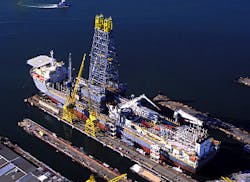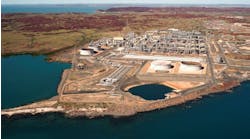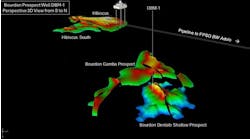Integrating handling systems and work flow
Steve Stegeman,Steve Woelfel
Transocean Offshore
The Transocean Offshore Discoverer Enterprise drillship undergoing final outfitting at Ingalls Shipbuilding in Pascagoula, Mississippi.
- Rigfloor graphic showing forward and aft work areas. [32,406 bytes]
- Running BOPs and drilling conductor hole. [19,815 bytes]
The Enterprise Class dynamically positioned (DP) drillships are dual-activity drilling rigs designed to drill, test, and complete ultra-deepwater wells to 35,000-ft drilling depth in water depths up to 10,000 ft. The patent-pending new generation dual-activity design resulted from work performed by Transocean to develop a cost-effective solution for worldwide ultra-deepwater drilling operations. The Enterprise Class drillships are designed to provide the industry with the capability to achieve the levels of efficiency and safety required for the economic development of ultra-deepwater reserves.
The drillships combine a dual-activity drilling equipment package consisting of advanced, high-capacity drilling equipment with a modified double-hulled shuttle tanker design. The result of this combination is a large multipurpose drilling rig designed to reduce well construction time, provide extended well testing and storage capabilities, and allow a range of subsea operations, including the J-Laying of ultra-deepwater pipelines.
The Enterprise Class drillships are DNV Class 1A1 MODU's designed to operate in harsh environments worldwide. They are designed to heave less than 7 ft in a 50-year Gulf of Mexico winter storm. The variable deck load and storage capabilities should provide the ability to drill multiple wells before resupply of well consumables is required.
Dual activity
Dual-activity capability should reduce well construction time by enabling operations to be conducted simultaneously in parallel, rather than sequentially in series as has traditionally been required due to equipment limitations. By-products of the dual-activity concept include an increase in well construction quality, reduction of nonproductive time due to advanced inspection and pre-testing capabilities, flexibility to perform a wide range of subsea jobs, and redundancy of technically advanced high-capacity drilling equipment.Simultaneous operations will necessitate a high level of job-specific planning to ensure the maximum reduction in critical path time is achieved. The scheduling of equipment and personnel coupled with real-time management of dual-activity operations will be essential to success.
Rig floor equipment on the Enterprise Class drillships is designed to minimize traditional roughneck "hands-on" work by utilizing a series of semi-automated pipe-handling equipment operated from remote touch screen and discrete controls. Pipe-handling equipment is capable of handling up to 20-in. OD tubulars in Range II fourbles (a four-stand) or Range III triples.
Dual-activity capability is provided by a forward work area and an aft work area, each centered around a rotary table. The rotary tables are spaced 40 ft apart above an 80-ft by 30-ft moonpool and are serviced by independent drilling equipment packages utilizing a dual 2 by 2,000,000-lb derrick.
The forward work area is equipped with tensioners and will be utilized as the primary rotary for drilling with riser and the BOP stack. The aft work area will be utilized for riserless drilling operations and will serve as a staging ground for preparation and testing of equipment to be utilized in the forward work area. Non-drilling subsea operations will also be performed from the aft work area.
The aft work area includes a 95-ft powered mousehole and a pick-up/lay-down system, and is designed to make up or lay down stands of drillstring or casing in singles. The pick-up/lay-down system picks a horizontal single off the conveyor and presents the single to the mousehole or the rotary in the vertical to be made up by an iron roughneck. The reverse process is utilized to lay down singles. The aft work area can be upgraded to serve as a second primary rotary for drilling with riser and a BOP stack concurrent with the forward work area.
Each pipe racking system can access drill string or casing stands from any position in the fingerboards and deliver the stand to either of the rotaries or the mousehole. Traveling assembly dolly retract capabilities will decrease tripping and connection times by allowing simultaneous operations with pipe-handling equipment at the rotary. Tripping can be conducted with elevators on the traveling block with the top drive assembly parked.
An adjustable casing fingerboard, a casing iron roughneck, and a hydraulic cathead are shared between work areas. Total pipe setback capacity shared between work areas is over 80,000 ft.
Drilling equipment
The drilling equipment to be used for dual activity drilling includes the following:- Two rotary support tables - 601/2-in., 1,000-ton hydraulic rotary tables and hydraulic power slips up to 750 tons.
- Two crown mounted compensators - 500 tons passive dynamic capacity each with 25-ft stroke, 1,000 tons retracted capacity.
- Two crown block/traveling block/rotating hooks - 1,000-ton powered rotating hook includes load pins to measure hookload.
- Two top drives - 1,150 HP 650-ton AC top drives with parking system.
- Two link/elevator sets - 500-ton links and hydraulic insert type elevators on both top drive and traveling block.
- Two drawworks - 5,000 HP DC with 2-in. drill line and regenerative braking rated for 1,000 tons with 12 lines.
- Two pipe racking system - vertical traveling column assembly with two hoisting jaws capable of handling Range II fourbles or Range II triples up to 30,000 lb.
- Two fixed fingerboard assemblies - capable of holding 30,375 ft of Range III triples of 6 5/8-in drill pipe, 1,240 ft of Range II fourbles of 6 5/8-in. heavy weight drill pipe, and 2,852 ft of Range II fourbles of 6 3/4-in., 8 1/4-in., and 9 1/2-in. drill collars.
- Two drillstring iron roughnecks - capable of handling up to 93/4-in drill collars with 100,000 ft-lb make-up torque and 120,000 ft-lb break-out torque, hydraulic spinning and torque wrench designed to handle stabilizers.
- Two manipulator arms - hydraulic work basket equipped with a maximum capacity of 14,000 lb at 8 ft and 1,500 lb at 48 ft.
- Four winches - hydraulic with 3/4-in. wire rope regulated for 12,000-lb line pull.
- Two driller work stations - four touch-screen displays controlling drilling and monitoring equipment in conjunction with joysticks through a computer network, located in climate-controlled cabins.
- Two assistant driller work stations - two touch-screen displays controlling drilling and monitoring equipment in conjunction with joysticks through a computer network, located in climate-controlled cabin.
- Two rig floor control panel - allows control of selected drilling equipment from rig floor.
Typical operations
A hazardous operations process is utilized to evaluate safety considerations for simultaneous dual-activity operations. It is anticipated that many new dual-activity capabilities will be identified as work experience with the Enterprise Class drillships and subsea operations grow and new technology is introduced.Upon arrival on location, the aft work area will be utilized to jet structural pipe in, drill conductor hole, and run and cement conductor casing and the wellhead while running the BOP stack in the forward work area. The drillships will be capable of saving several days of rig time by making short well mobilizations at one to two knots with the riser and BOP stack suspended.
While conducting normal drilling operations through the riser in the forward work area, operations that can be conducted out of the critical path in the aft work area include:
- Inspect, make up, and rack back drill pipe and BHA's
- Function test motors and MWD equipment
- Make up, test, and rack back casing, hangers, running tools, and cementing equipment
- Make up, test, and hang-off or rack back electric line logging equipment
- Make up, test, and rack back DST equipment
- Make up, test, and rack back completion equipment
- Make up, test, and run subsea trees to the mudline
- Jet template structural pipe
- Batch drill and set template conductor casing and wellhead
- Install subsea equipment (pilings, manifolds, jumpers, and flowlines)
Deck handling systems
Four 60 metric tons (rated) knuckleboom cranes with rigid lifting attachments are utilized to lift tubulars and riser from deck storage areas to conveyors located forward and aft of the derrick. The rigid assembly includes rotating and telescoping capabilities allowing precise positioning in all weather conditions. The rigid lifting attachments are controlled remotely from the knuckleboom crane control cabin and consist of a gripper and an electromagnet mounted on yokes for handling tubulars and a yoke with flange grippers for handling riser. The knuckleboom assembly can be removed to allow for increased loads to 75 metric tons.The conveyors are capable of transporting tubulars up to 36-in. OD and 20,000 lb to the rig floor. Riser-handling carts driven by the conveyor belt are utilized to accommodate heavy riser loads by transmitting the load to the conveyor frame. The aft conveyor includes a tubular loader and unloader that is capable of loading and unloading singles from a feeder table.
There are four 7,500-psi mud pumps with 14-in. strokes and room for an additional two mud pumps. The active mud system consists of twelve 500-bbl pits and the reserve mud system consists of six 1,500-bbl pits. There are four 100-bbl slugging pits, three 100-bbl trip tanks, and one 10-bbl mini-trip/stripping tank. Solids-control equipment consists of eight cascading shale shakers and two desander/desilter sets. There are four degassers capable of handling 1,000 gpm each.
The mud system provides the flexibility and capacity to store and quickly utilize multiple mud and completion fluid systems while retaining sufficient capacity to displace the riser if required (10,000-ft riser capacity - 3,650 bbl). Significant improvements in drilling rate of penetration should be achieved by utilizing the improved hydraulics at the bit that can be attained with 7,500 psi mud pumps. A 65/8-in. drillstring tapered to 5 in. when required will be utilized on the Discoverer Enterprise to maximize hydraulic capabilities.
The bulk system consists of four 4,000 cu ft tanks for gel and barite and four 4,000 cu ft tanks for cement. The cement unit includes triplex pumps rated to 15,000 psi and 7,500 psi driven by DC electric motors.
BOP, riser systems
The 15,000 psi 183/4-in. multiplex BOP stack on the Discoverer Enterprise consists of six rams and a combination annular/lower flex joint. Three of the rams are 41/2-in. to 7-in. variable bore rams with 151/2-in. operators, two of the rams are blind/shear rams with 22-in. operators, and one ram is a casing shear ram with 22-in. operators capable of shearing 133/8-in. casing. The annular is rated for 10,000 psi.Temperature and pressure probes and a gas bleed valve under the annular are incorporated in the BOP stack. The stack is 45 ft in height and is capable of being handled in one piece below the substructure on the moonpool deck with the use of a powered cart system with tracks on the moonpool deck and on powered spider beams. A dedicated combination low-pressure/high-volume and high-pressure/low- volume BOP test pump system rated to 15,000 psi will reduce pressure testing times.
Riser joints are 75 ft long with a 21-in. OD and 13/16-in. wall thickness. Riser couplings are rated for 2.5 million lb and the riser is equipped with 41/2-in. ID 15,000 psi choke and kill lines, a 3.82-in. ID 6,000 psi boost line, and a 2.62-in. ID 5,000 psi hydraulic supply line. The Discoverer Enterprise has storage capability for up to 20,000 ft. of 21-in. riser.
Six 400-ton solid body tensioners with 50-ft. strokes provide a tensioning capability of 4.8 million lb. A riser tensioner ring with a fluid assist bearing is utilized providing low break-out torque. Split construction with hydraulic locking pins significantly reduces make-up time.
Three flex joints are utilized in the riser string - an upper flex joint at the diverter, an intermediate flex joint below the slip joint, and the lower flex joint combined with the annular. The slip joint has an 85-ft stroke and a profile machined in the inner diameter of the outer barrel to allow engagement with a BOP landing assist tool.
The BOP landing assist tool will enable the latching and unlatching of the BOP stack utilizing the drawworks and compensator in combination with the tensioners. This landing combination eliminates the time associated with nippling down the diverter and rigging up a landing joint. A BOP test plug can be run below the BOP landing assist tool out of the critical path to allow testing of the BOP stack immediately after latching up.
The tensioning capability of the Enterprise Class drillships and room underneath the substructure will allow installation of a high pressure concentric riser in the 21-in. marine riser with a surface.
Subsea equipment handling
Clearance of 60 ft between the moonpool deck and the substructure allows handling of subsea trees and other large subsea equipment in single pieces utilizing the powered cart system. Components will be loaded directly on carts from supply boats and fully tested in the moonpool deck area before the component is run to the seafloor out of the critical path. The Discoverer Enterprise is equipped with two 150 HP ROV units that can be launched selectively outboard of the drillship or through the moonpool utilizing the moonpool deck track system for transport.A production test train on the Discoverer Enterprise capable of testing 20,000 b/d of oil and 100 MMcf/d of gas and produced fluids storage capacity of 138,000 bbl will provide extended well testing capabilities to determine well and reservoir characteristics. An onboard permeable membrane, nitrogen-generating system is utilized to produce an inert pad for produced fluid storage. The nitrogen will also be used for selected control functions and for powering the crown mounted compensators and riser tensioners.
A triple redundant dynamic positioning system will be utilized to control the six 7,000 HP fully azimuthing thrusters to keep the Enterprise Class drillships on location. The primary positioning reference systems are a differential global positioning system and a long/ultra-short baseline acoustic positioning system. Additional equipment tied into the dynamic positioning system that provide referencing data include gyro compasses, wind sensors, vessel motion sensors, vessel draft sensors, flex joint angle indicators, and a doppler current meter. The dynamic positioning system is part of an integrated automation system that includes a power management system and a vessel management system.
References
Sikes, J., et al., "J-Laying deepwater pipelines with drillship and threaded connections," Offshore, October, 1995.Cole, J.C., et al., "Discoverer Enterprise: World's Most Advanced Drilling Unit," SPE/IADC 37659 presented at the SPE/IADC Conference in Amsterdam, March 4-6, 1997.
Cole, J.C., et al., "New ultra-deepwater rig with dual rotaries will reduce costs," Oil & Gas Journal, May 26, 1997.
Wilburn, M.D., et al., "Deepwater Rig Design for 10,000 Feet of Water," OTC 8753 presented at the OTC Conference in Houston, May 4-7, 1998.
Shaughnessy, J.M., et al., "Concentric riser will reduce mud weight margins, improve gas-handling safety," Oil & Gas Journal, November 2, 1998.
Copyright 1999 Oil & Gas Journal. All Rights Reserved.




